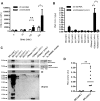Release of Active Peptidyl Arginine Deiminases by Neutrophils Can Explain Production of Extracellular Citrullinated Autoantigens in Rheumatoid Arthritis Synovial Fluid
- PMID: 26245941
- PMCID: PMC4832324
- DOI: 10.1002/art.39313
Release of Active Peptidyl Arginine Deiminases by Neutrophils Can Explain Production of Extracellular Citrullinated Autoantigens in Rheumatoid Arthritis Synovial Fluid
Abstract
Objective: In the majority of patients with rheumatoid arthritis (RA), antibodies specifically recognize citrullinated autoantigens that are generated by peptidylarginine deiminases (PADs). Neutrophils express high levels of PAD and accumulate in the synovial fluid (SF) of RA patients during disease flares. This study was undertaken to test the hypothesis that neutrophil cell death, induced by either NETosis (extrusion of genomic DNA-protein complexes known as neutrophil extracellular traps [NETs]) or necrosis, can contribute to production of autoantigens in the inflamed joint.
Methods: Extracellular DNA was quantified in the SF of patients with RA, patients with osteoarthritis (OA), and patients with psoriatic arthritis (PsA). Release of PAD from neutrophils was investigated by Western blotting, mass spectrometry, immunofluorescence staining, and PAD activity assays. PAD2 and PAD4 protein expression, as well as PAD enzymatic activity, were assessed in the SF of patients with RA and those with OA.
Results: Extracellular DNA was detected at significantly higher levels in RA SF than in OA SF (P < 0.001) or PsA SF (P < 0.05), and its expression levels correlated with neutrophil concentrations and PAD activity in RA SF. Necrotic neutrophils released less soluble extracellular DNA compared to NETotic cells in vitro (P < 0.05). Higher PAD activity was detected in RA SF than in OA SF (P < 0.05). The citrullinated proteins PAD2 and PAD4 were found attached to NETs and also freely diffused in the supernatant. PAD enzymatic activity was detected in supernatants of neutrophils undergoing either NETosis or necrosis.
Conclusion: Release of active PAD isoforms into the SF by neutrophil cell death is a plausible explanation for the generation of extracellular autoantigens in RA.
© 2015 The Authors. Arthritis & Rheumatolgy published by Wiley Periodicals, Inc. on behalf of the American College of Rheumatology.
Figures





References
-
- Wright HL, Moots RJ, Edwards SW. The multifactorial role of neutrophils in rheumatoid arthritis. Nat Rev Rheumatol 2014;10:593–601. - PubMed
-
- Brinkmann V, Reichard U, Goosmann C, Fauler B, Uhlemann Y, Weiss DS, et al. Neutrophil extracellular traps kill bacteria. Science 2004;303:1532–5. - PubMed
-
- Leon SA, Revach M, Ehrlich GE, Adler R, Petersen V, Shapiro B. DNA in synovial fluid and the circulation of patients with arthritis. Arthritis Rheum 1981;24:1142–50. - PubMed
Publication types
MeSH terms
Substances
Grants and funding
LinkOut - more resources
Full Text Sources
Other Literature Sources
Medical
Research Materials
Miscellaneous

